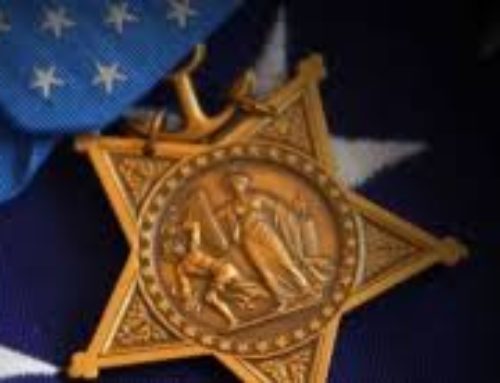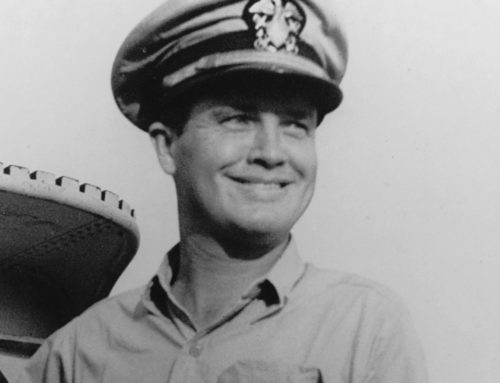Eugene Bennett Fluckey was born in Washington, D.C. on October 5, 1913 to Isaac Newton and Louella Snowden Fluckey. A bright child, 10 year old Eugene heard a speech by President Calvin Coolidge, in which he told the Nation:
“Press on. Nothing in the world can take the place of persistence. Talent will not: Nothing is more common than unsuccessful men with talent. Genius will not: Unrewarded genius is almost a proverb. Education alone will not: The world is full of educated derelicts. Persistence and determination alone are omnipotent.”
This message hit home hard with young Eugene; so hard that he would venerate the President, even naming his dog Calvin Coolidge. According to Fluckey, he would closely follow Coolidge’s words and philosophy during his studies. After finishing school at Columbian Prepatory School, Fluckey would sit for the United States Naval Academy’s entrance exam. Believing that he should not just do, but excel, he achieved the top scores for the entrance exam and later graduated from the academy in the top ¼ of his class (107 out of 464).1
Fluckey spent his first two years aboard the surface ships USS Nevada and USS McCormick. In 1938 he transitioned to the Submarine Service and attended Submarine School in Groton, CT. As the country entered WWII, in 1941, Fluckey served aboard the pre-war “b” class submarine, the USS Bonita; serving 5 war patrols in the Pacific.
After this tour, Fluckey would enter postgraduate school for engineering. In 1943 he was promoted to Lieutenant and sent to Prospective Commanding Officer’s school. In late 1943, Fluckey, was assigned to the USS Barb (SS-220), eventually taking command of her one year after he first stepped aboard.2
The Barb was sent to Formosa Strait in early 1945 to attack supply ships that were supporting Japanese ships that were taking action against the United States and the Philippines. In January 1945, the Barb, USS Picuda (SS-382), and the USS Queenfish (SS-393) were sent to the China Sea, where they would act as a “cork in the bottle” and actively deny the use of the Formosa Strait by Japanese shipping. On January 8th, Barb, Picuda, and Queenfish encountered eight large Japanese merchant ships and their four patrol ships. During this attack, Fluckey would sink four of the merchant ships – a considerable success!
The weeks following this attack would prove fruitless for the Barb, frustrating both Fluckey and his crew. In this time they would not encounter one single enemy vessel. Time was slow and tensions were high. Finally, on January 22, the Barb spied a large Japanese convoy in the area of Namkwan, China. Fluckey, using the low visibility of the evening and the shallowness of the harbor, ordered a surprise surface attack. At 0300, under the cover of darkness, the Barb slipped past a Japanese escort ship that was guarding the harbor entrance. Fluckey now had a clear run at the silent, waiting convoy. The large convoy was anchored neatly in 3 lines parallel to the coast – a perfectly packaged gift for Fluckey and his men3. Fluckey gave the order and Barb fired her bow torpedoes at the tightly packed convoy from 3000 yards out. Fluckey immediately swung the Barb around to fire more shots. The air was filled with fire, smoke, and chaos as Barb’s shots hit their marks. Four ships were sunk (including a large ammunitions ship) and another three were heavily damaged.
With the damage done and a Japanese frigate in close pursuit, Fluckey ordered Barb to make a speedy surface run to the safety of deep water. As a diversion, Fluckey took Barb to emergency power and steered her through an area marked “unexplored” on the navigation charts. This route took Barb towards the hazards of nearby rocks, shoals, and possible mines. In its race towards the shoals, Barb’s radar picked up a group of Chinese junks. Fluckey called for the Barb to pass directly through the junks. With the Barb in its sites, the Japanese frigate opened fire. The torpedoes meant for Barb struck the Chinese junks. In the ensuing commotion, Barb was able to escape further attack, by heading out to deeper water4. It was this type of act that led to his earning the nickname Lucky Fluckey. It would also be the moment that would lead to his receipt of the Medal of Honor in March of 1945.
Later that summer, Barb would become the first American submarine to become armed with rockets. In July, Barb was ordered on a sabotage mission. Standing 900 yards offshore, Fluckey sent two rubber boats, holding eight men onto the southern shore of the Japanese island, Sakhalin Island. They were to plant explosives on railroad tracks 400 yards inshore. On their departure, Fluckey sent them off saying, “Boys, if you get stuck, head for Siberia, 130 miles north.” They would not need this advice, as they successfully planted the explosive charges and made their way back to the Barb. A 16-car train came by as the convoy was returning, setting off the explosives. According to the men, wreckage was thrown 200 feet into the air.5
Fluckey remained in the Submarine Service, commanding both the USS Dogfish (SS-350) and the USS Halfbeak (SS-352). He would also serve at COMSUBPAC, finally retiring as a Rear Admiral, in 1972, after 37 years of service.2
1 Undersea Warfare Magazine – Historical Reflection, by Eugene Fluckey
2 United States Naval Academy Biological Chronology of Eugene Fluckey
3 World War II Medal of Honor Recipients (1) Navy & USMC – R. Hargis and S. Stinton
4 Thunder Below – Eugene B. Fluckey
5 New York Times – article by Richard Goldstein





